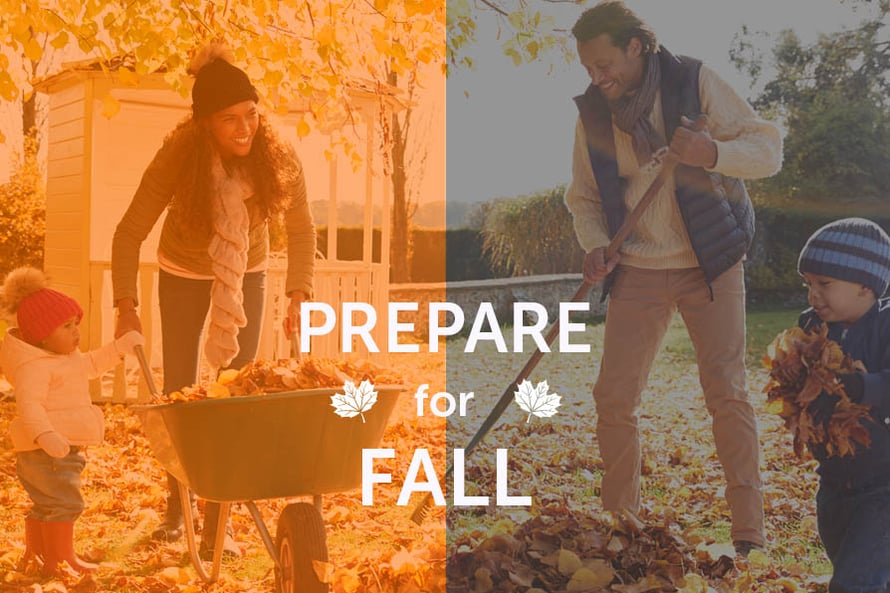Preparing your home for fall and the upcoming colder days can mean different things to different people. For some, preparation might include getting out the seasonal decorations, stocking up on fall-smelling candles, and drinking pumpkin spice-flavored drinks. For others, preparation can be more extensive, especially if you live in an area that gets very cold. Below are seven practical ways to prepare your home for fall and winter.

1. CLEAN OUT YOUR GUTTERS
Keeping leaves and debris out of gutters can save you money and prevent a headache down the road if the gutters get blocked up. Water can gather and stand around your home's foundation when gutters are blocked, causing cracks. In addition, animals can make dirty gutters their home, which is best to avoid. Prevent water and roof damage by cleaning your gutters regularly.
2. MAKE YOUR HOME TIGHTER
Our homes are like envelopes; the tighter they’re sealed, the less air escapes from them. With the air getting colder, it’s a good idea to make your home tighter to help you stay warm and save you money. Weatherstrip or caulk small cracks in your home’s doors and windows to close any openings to the outside. You can also use spray foam to seal any gaps. If your windows are older, reglaze them to offset lots of weather exposure. Insulation is key.
3. CHECK SMOKE DETECTORS
Check and replace your smoke detectors and carbon monoxide batteries often and throughout your home. To keep track of your maintenance, you could place a piece of masking tape on the detector with the date you last changed the batteries. You should change the smoke detector batteries at least once yearly and carbon monoxide batteries every six months. Replace each smoke detector alarm every 10 years and carbon monoxide alarms every 7-10 years.
4. CLEAN YOUR FIREPLACE AND CHIMNEY
If you have a fireplace and chimney, you may be ready to use them regularly again. However, before starting it up for the first time, ensure it's inspected and clean. Some experts say it’s best to clean your fireplace after every 50 uses or at least once a year. Even if you rarely use your fireplace, animals may make homes inside the chimney that you’ll want to remove. Do not rely solely on chimney cleaning logs to clean your chimney. Professional chimney sweeps can help you completely rid your chimney of buildup safely and efficiently.
5. STOCK UP ON SALT FOR ICE AND SNOW
Living in an area where there is snow and ice isn’t always easy. Stocking up on salt and anti-freezing products in advance could be helpful. This guarantees you will have it when needed, and you don’t have to risk driving to a store in bad weather to get it.
6. BUY SHOVELS AND RAKES
If you don't already have any, buy rakes for fall leaves, shovels for snow, or be ready with whatever method you prefer to get leaves and snow out of your path. If you already have rakes and shovels, ensure you know where they are (perhaps it’s time to clean out the garage) and check that they’re still in working condition.
7. CHECK YOUR FURNACE
All heating systems need to be serviced at least once a year to ensure everything is working efficiently. Check the area surrounding your unit to ensure it’s clean. If you have a disposable filter, make sure to replace it when recommended. If you have a permanent filter, remember to clean it. If your system needs to be fixed or replaced, you could consider switching to a geothermal system. Geothermal is a great way to heat your home in the colder months and cool your home in the warm seasons.
WHAT IS GEOTHERMAL?
Geothermal takes heat from the ground and pumps it into your home to heat your home, and in the warmer seasons, it extracts heat from your home and puts it into the ground, keeping you comfortable all year round. You can even use it to heat your driveway to avoid snow and ice on your driveway in the winter and eliminate the need for carbon monoxide alarms in your home. It's environmentally responsible, significantly reducing greenhouse gas emissions, and geothermal saves you money over time. By utilizing the constant temperature below the ground, your geothermal system doesn’t have to work as hard when heating or cooling your home. Its efficiency can save you money because the monthly cost is cheaper than other forms of heating and cooling your home. On top of that, there is a 30% federal tax credit for geothermal units and possibly state and local rebates, saving you money on the installation cost. If you’re interested in getting geothermal, now is a great time to do so!
Chat with us to see how much you could save with geothermal and if your home qualifies. We would be happy to speak with you!


